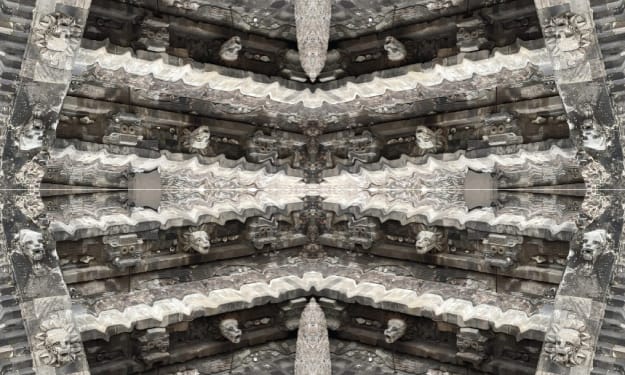How to Make a Ribbon, Lacework and Tapestry Cushion
A step-by-step guide on how to make a ribbon, lacework and tapestry cushion. Picture illustrations are given along with information supporting it. Different fabrics for the cushions are used in this article

(Please ignore the bad lighting/editing or white cut-offs done on the images in this article, as the images were taken from a very old and classical book from my library)
(Links to certain terms and methods are highlighted in a different colour. Click the link and it will take you the article accordingly)
Using Special Fabrics
Making a cushion cover provides the ideal opportunity to give new life to a small fragment of an old or unusual fabric.
The choice of fabric extends from the relatively well known, such as an antique lace or European needle point, to the unfamiliar, like the panel of a Central African raffia skirt or part of a kilim.
Many such fabrics are delicate, either intrinsically or through age, and they should be reinforced by being mounted on a strong backing cloth. It is also advisable to make up a cushion that an safely be dismantled later, leaving a precious textile intact for framing or further use.

Ribbon and Lacework Cushion
There are many examples of lacework, such as trimmings on garments, tablecloths, napkins, bedspreads, pillows, and sheets.
When used as a decorative edging, lacework or fine linen can transform a simple cushion cover to a fancy antique furnishing.
The size of the cushion is determined by the amount of lace or linen you have available. The cushion below has also been trimmed with ribbons and buttons.
In addition to the lace and adornments, to make this cushion, you will need cushion fabric, inner pad, and the basic sewing kit. Try to avoid using side zip fastening with lace edgings.






Safety Notice
As there are people out there who are just beginning on their journey of complete home furnishing. I would advise taking great care when it comes to dealing with sharp knives, scissors and especially pins.
1. Marking Panel: Lay the front panel for the cushion cover right side up, tack the seam line 1.5 cm (5/8 in) from the panel edge, and mark the placement for the outer ribbon parallel to the seam line.

2. Attaching Ribbon: Following the marked line, pin and tack the ribbon bordering the pattern in place on the face of the front panel. Attach the ribbon by slip stitching it along the edges, mitring at the corners and hiding the necessary joins.

3. Attaching Decorations: Stitch the buttons and bows in place and make up the cover. Lay the lace along the edge and mark the position of the corners on it.

4. Attaching Lace Edging: Stitch the lace to the cushion edge by hand. Use small, even slip stitches. Bad stitching may be camouflaged by the lace, but it will be weak and not hold in place for too long.


Tapestry Cushion
Mane densely woven and needle-worked textiles, such as kilims and tapestries, make colorfully patterned cushion covers. However, such delicate textiles need backing for added strength. The backing also prevents the inner pad from showing through any gaps in the weave of the fragment.
In addition to the chosen textile and the backing material, there are basic things you need to make this cushion. You will need an inner pad, the fastener you have chosen, and the basic sewing kit.





Safety Notice
Where silicon padded gloves if necessary and make sure you use a pin cushion for all your collection of pins. Stay away from the fireplace in your house, as the majority of the fabrics are highly flammable.
1. Cutting Out Panels: Lay the tapestry on a piece of backing fabric, and secure it with pins. Working carefully, cut out the backing fabric, closely following the edge of the tapestry. Cut out the fabric for the back of the cushion using the same technique.

2. Attaching Backing: Lay the tapestry face up on the right side of the backing. Pin and tack together. Place tapestry and back panel right sides facing. Pin and tack along the edge, leaving a 1.5 cm (5/8 in) allowance.

3. Joining Panels: Following the tacking stitches, sew the front tapestry panel and the back panels together as appropriate for the fastening method you are using. Remove the tacking stitches, and clip the seam allowance at the corners, taking care to avoid cutting through the old fabric.


Fabric Options
Cushion cover can be made from a variety of fabrics, provided that the fabric is suited to the decorative or the functional use of the cushion.
For colour and delicacy, there are fine dress materials, such as muslin, which may have to be strengthened by backing with a stronger cloth.
Because it is a light yet durable fabric. Silk is ideal for use in making cushion covers, although the finest weaves need to be lined.

In a more exotic vein, the richly varied hand-woven and printed or embroidered and folk textiles of Africa and India make ideal complements, and contrasts in pattern and texture, to ordinary furnishing fabrics.

When Seeking a more hand-wearing material, look out for densely woven rug fragments from well-worn oriental carpets or kilims, or a piece of closely worked old needle-point.

About the Creator
Temoor Dar
💡Topic: Entrepreneur and Writer💡
♟️Hobbies: Traveling, Poems, Playing Chess and Solving Puzzles♟️
🎂Born: July 7, 1991🎂
📍Born in Stockholm, Sweden, and now a Londoner since 1996📍
📚Lifelong Learner📚
🌟Wisdom from Mentors🌟
Enjoyed the story? Support the Creator.
Subscribe for free to receive all their stories in your feed. You could also pledge your support or give them a one-off tip, letting them know you appreciate their work.






Comments
There are no comments for this story
Be the first to respond and start the conversation.